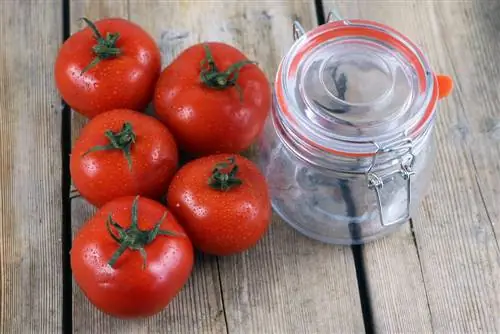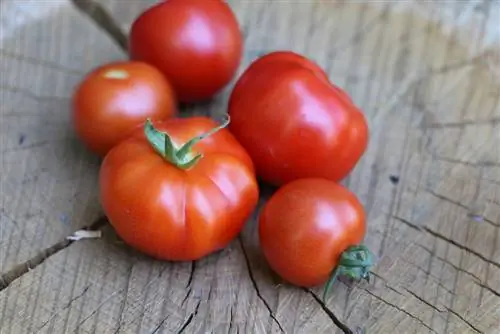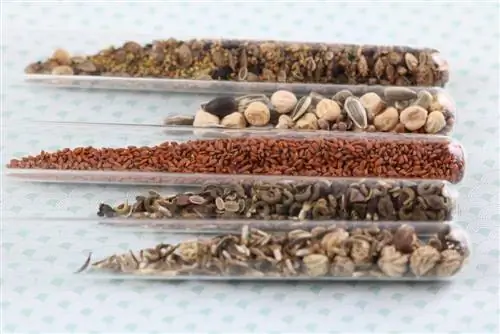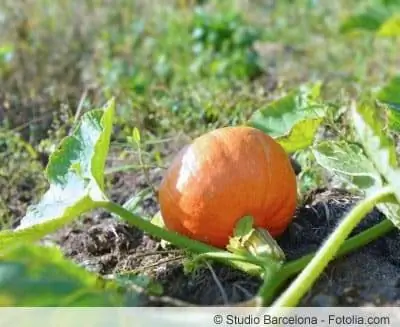- Author admin [email protected].
- Public 2023-12-17 03:39.
- Last modified 2025-01-24 12:45.
Harvesting your own tomatoes is a highlight in the gardening life of many hobby gardeners. Freshly harvested, the red fruits taste much better than from the supermarket and the selection of varieties seems to increase every year. To ensure that your harvest is plentiful, you should proceed carefully and planned when sowing.
When and where should I sow tomatoes?
The ideal time for sowing depends on various factors. The most important factor is the future location of your tomato plants (outside or greenhouse), as this has a significant influence on the time at which you can plant out your young tomatoes. There shouldn't be too much time between sowing and planting out, otherwise the small plants will suffer from horny growth and are not particularly resilient. If you sow very late, your tomatoes will have less time to ripen and your harvest may be smaller than necessary. To achieve a particularly long harvest time, you can also sow at different dates.
Cultivation outdoors
If you are planning to grow tomatoes outdoors, but would like to prefer the plants on the windowsill or in the winter garden, then sowing from mid-February to mid-March is recommended. Sowing directly outdoors only makes sense from mid to late May (after the Ice Saints), as night temperatures below around 15 °C can harm the seedlings.
Growing in a greenhouse
In a heated greenhouse you can plant your tomato seeds in the ground as early as February. However, be sure to ensure an even temperature during the germination period. After pricking, it can be a little colder (around 16 °C to 18 °C). If your greenhouse is unheated, wait until it is warm enough (around mid-March to mid-April) or prefer to keep the plants indoors on the windowsill.
What do I need for sowing?
- Growing pots or bowls
- special potting soil or self-mixed substrate
- Light
- even temperatures from 20 °C to 28 °C
- room temperature, low-lime water
Growing pots or bowls?
Many varieties of growing pots, bowls and pallets (multi-pot pallets) are available in stores. Which option you prefer may also depend on the space available. If you use small pots or multi-pallets, you can usually save yourself having to prick out the young plants. However, you should remember that tomato plants now have slightly higher nutrient requirements.

You can place biodegradable pots in the ground with the tomato plants. This makes work easier and is more environmentally friendly than using plastic pots. Of course, you have to cut multi-pot pallets made of this material apart beforehand.
Special potting soil or self-mixed substrate?
Tomato seeds need a nutrient-poor substrate for germination and good root formation. This may seem a bit paradoxical to you, as tomato plants are heavy feeders. However, in a nutrient-rich substrate, the seedling has no reason to develop strong roots, as the nutrients are easily absorbed even without them. Later, when there is a high demand during fruit ripening, the strong roots are missing and your tomato plant is under-supplied.
You have the choice between special potting soil or mixing your own substrate. Mixing equal parts sand and peat is relatively easy. If you want to use garden soil, do not use the top layer of soil. You should also sieve and sterilize the soil. This makes the soil nice and fine and kills insect eggs, fungal spores and bacterial pathogens. Sterilization only takes about 10 minutes in the microwave (at 800 watts), and about half an hour in the oven at about 150 °C.
Tip:
Depending on the nutrient content of your soil, mix soil and sand in a ratio of 1:1 (nutrient-rich soil) or two parts soil to one part sand (nutrient-poor soil). You can also mix in some mature compost (ratio 1:1:1). This mixture is particularly useful after pricking out when the nutrient requirements increase.
Light
Tomato seeds are light germinators. If you sow the seeds too deep they will not germinate. The same applies if you place the seed pots in a dark place for germination. However, the blazing sun, especially during midday, is not good for the sensitive seedlings. Don't start tomato seeding too early in the year. The length of the day or the amount of light per day also plays an important role in germination.
Consistent temperatures
Tomato seeds need at least 18 °C to germinate. However, they germinate best at temperatures between 22°C and 28°C. It's best to avoid higher fluctuations, then all seeds will germinate relatively simultaneously and strong plants will develop from them.
Room temperature, low-lime water
Cold and lime-rich water is not good for your tomato seeds. They tolerate soft rainwater best. If this is not available to you, then use stale tap water for watering. Either water very carefully so that the seeds are not washed out of the substrate, or you spray the substrate with a flower sprayer.
How useful is a greenhouse?
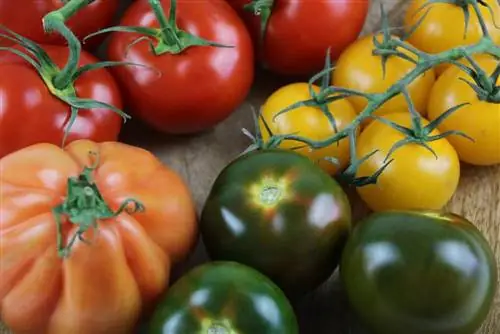
The seeds and seedlings of tomato plants are still relatively sensitive. At the beginning they cannot tolerate drafts. Germination also requires consistent heat and constant moisture. Both can be easily regulated in a greenhouse. A mini or indoor greenhouse is very helpful for germination on the windowsill. Alternatively, you can cover the cultivation pots with a transparent film. Then you should remember to ventilate daily, otherwise your seeds and/or seedlings could rot.
Sowing step by step
- fill special potting soil into small pots or a shallow bowl
- press small holes in the earth
- Put seeds into these holes one at a time
- Close seed holes so that the seeds are covered by a maximum of about 0.5 cm high
- Place the cultivation containers in a bright, warm place
- Moisten the substrate (water or spray carefully)
- ensure even heat and substrate moisture
- Germination temperature: about 18 °C to 28 °C
- Germination time: approx. 3 to 10 days
Tips for pricking out and caring for young plants
- Pick out the seedlings after about three to four weeks, ideally when at least three leaves have formed.
- Now use a slightly more nutrient-rich substrate than you used for the seeds so that your tomato plants are optimally supplied.
- When planting, place the seedlings a little deeper into the soil than they were before, this will stimulate root formation a little more.
- Keep the transplanted young plants a little cooler than during germination. Approximately 16 °C to 20 °C is sufficient. This makes the plants stronger. If kept too warm, the plants become yellow and weak.
- Don't prick too late. If the seedlings remain in the nutrient-poor growing substrate for too long, then they will be taken care of.
- If you sow your tomato seeds individually in biodegradable pots, then pricking out is no longer necessary. Instead, add a little mature compost to the growing substrate or later to the top of the pot.


